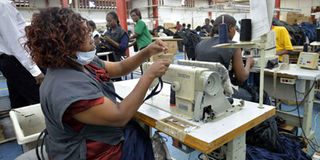Breaking: Autopsy reveals how Cyrus Jirongo died
Premium
Road to an export-oriented economy

Workers at United Aryan Export Processing Zone, Nairobi. PHOTO | FILE | NATION MEDIA GROUP
What you need to know:
Our unemployment rate is arguably one of the highest in the East African region.
Unaddressed, the unemployment ratio and ever-increasing youthful population could escalate into a major social challenge.
Currently, the textiles and apparels sector employs 52,000 people in the Export Processing Zones, 21,000 outside EPZs and over 30,000 people in the informal sector.
Today, Kenya finds itself in an awkward yet promising position in its history.
For one thing, our unemployment rate is arguably one of the highest in the East African region. Additionally, Kenya’s youth (between 18-35 years) account for over 30 per cent of the total population, and over half of the country’s population is below 35 years.
Unaddressed, the unemployment ratio and ever-increasing youthful population could escalate into a major social challenge. On the other hand, a growing youth population is a key asset to the nation if we view it in terms of its capability to sustainably provide innovation and labour for economic development.
Labour is an important function in the unit cost of production. The significance of this input varies from product to product. As such, governments across the world support sectors where the labour input is high so as to address unemployment challenges.
LABOUR-INTENSIVE
The most labour-intensive value chain is the cotton-textiles-apparels value chain; with massive employment being created in apparel/garment manufacturing and cotton farming.
This is the main reason for the government’s decision to deliberately employ measures to grow the cotton-textiles-apparels value chain.
Currently, the textiles and apparels sector employs 52,000 people in the Export Processing Zones (EPZs), 21,000 outside EPZs and over 30,000 people in the informal sector.
Additionally, the sector provides a steady market to approximately 30,000 small scale cotton farmers and to over 100,000 people indirectly.
In 2017, Kenya exported textiles and apparels products worth over 40 billion to various markets around the world, with the US market taking 85 per cent of the exports.
COMPETITIVENESS
The export market, as we know, is very sensitive to price; thus the need to ensure that as a country we have a good blend of features that promote competitiveness and support export-oriented manufacturing.
Our internal assessments against buyer proposals indicate that apparel manufacturers are 15 per cent less competitive compared to global competitors.
The rate is even higher in the textiles and fibre production.
Nonetheless, our major advantage lies in having a highly productive labour force. Our literacy levels are also relatively high at over 70 per cent for women and 80 per cent for men, making the Kenyan population an ideal source of a competent workforce to drive production.
For the workforce, we have made it a tradition as a country to always announce a ceremonial wage increase on May 1.
Even though the move aligns labour with commensurate pay, it is an unsustainable policy that fails to take into account other salient features in a market-driven economy.
INFLATION
The rate of inflation and the high cost of living in the country normally washes away the gains made by employees in the minimum wage increases.
This has a result of raising the cost of labour in the country without necessarily translating to an improved lifestyle for the employees.
The high cost of labour translates to a higher cost of production, leading to the shutdown of manufacturing activities in the country. Ultimately, the employees suffer as investors move to low-cost production countries.
As such, it is important to have in place measures that enhance the competitiveness of sectors such as textiles and apparels by, among other things, having in place strategic measures that lower the cost of living and improve the productivity of the workforce.
This can be achieved by having in place productivity-based labour and wage regulations that encourage output per capita.
LARGER INCOMES
These kinds of frameworks would result in employees going home with larger incomes than the ‘usual’ minimum wages.
We can also embark on focused strategic training and development to enhance the skills of the Kenyan labour pool to enhance productivity.
Lastly, the government can lower the cost of living by cutting taxes on the food basket, incentivizing the production of products in the basic food basket, having in place affordable social housing, an efficient public transport system, and affordable/universal healthcare.
The government can also consider instituting impactful incentive programs for manufacturers to cushion them against high costs of production so as to attract and retain investments in the country.
If this is done, Kenya can benefit from its early starter position and wave away rising competition from the growing African Lionesses and the rejuvenating Asian Tigers.
Mr Bedi is the Apparel Exports Sub-Sector chair at Kenya Association of Manufacturers (KAM). [email protected].





